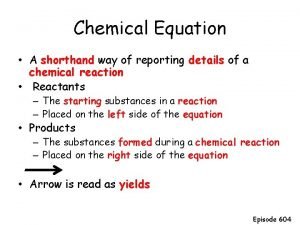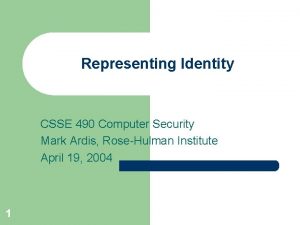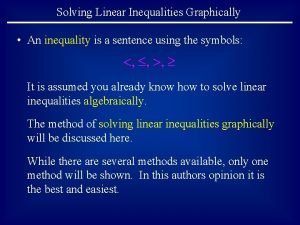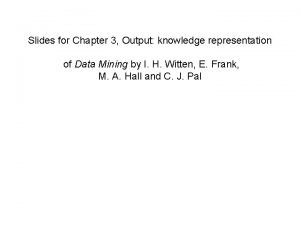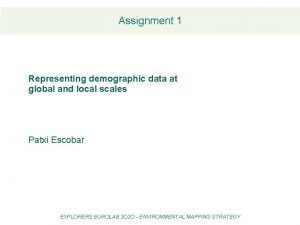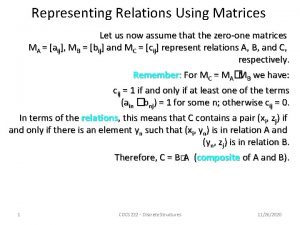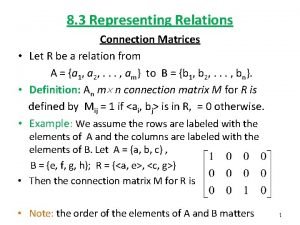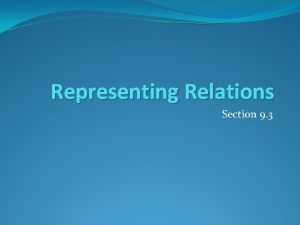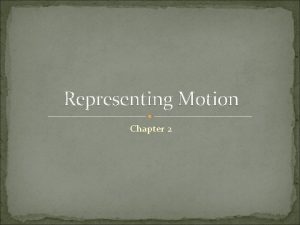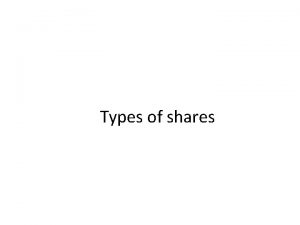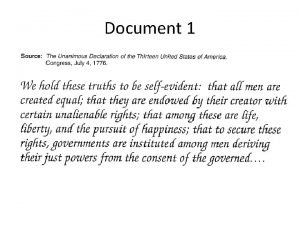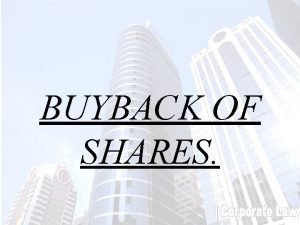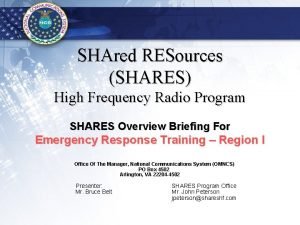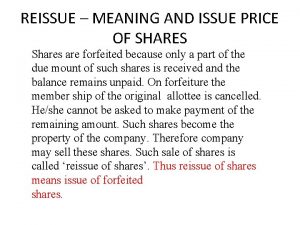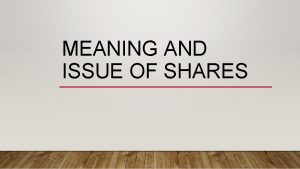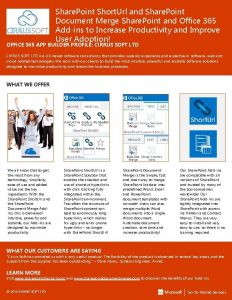Shares Shares A share is a document representing























- Slides: 23

Shares

Shares • A share is a document representing part ownership of a company • Each share is a title to ownership on the assets of the company • Shares are investment that carries risk but they offer a return in the form of: – Dividends paid yearly – A capital gain from an increase in the market price of shares

Rights of shareholders • Shareholders are members and owners of a company • A share confers legal rights on owners – A right to a share in any declared dividend – Attendance and voting rights at the annual shareholders meeting – On winding up the company, shareholders have a right to a share of any remaining assets left after all outstanding debt has been paid off

Equity v debt finance Shares • Term is unlimited • Shares have a nominal value • Shareholders have voting rights • Dividends are paid depending upon performance • Dividends are an appropriation of profits • Dividends are paid after corporation tax Loans or debt finance • Fixed term with a maturity date • Loans require security • No voting rights • Interest is payable on loans • Interest is an allowable expense for corporation tax • If a company is wound up lenders appear at the top of the list for

Share capital • This refers to money invested in a limited company as consequence of the issue (sale) of shares • It is equal to the number of issued shares x the nominal value of shares • Share capital is a permanent source of funds for a company and is recorded on the balance sheet • If individual shareholders wish to recoup their investment they have to find another

Share capital • Authorised share capital – Maximum value of shares which a company is allowed to issue-this will be listed in the memorandum of association • Issued share capital – Amount of shares actually issued-cannot be greater than the authorised share capital • Called up capital share – The amount of issued capital that has been fully paid to the company by shareholders.

Public limited companies • A public limited company must have authorised share capital of at least £ 50 k • It becomes a public company by stating that it is a public company • Shares in a public company may be bought and sold in an open market • Provided it satisfies certain conditions, the shares of a public company can be listed on the Stock Exchange • Public companies are less numerous but

Private company • Any company that does not make its shares available to the public is a private company • There is no minimum authorised share capital • Shares in private companies are generally subject to restrictions on sales e. g. they must be offered to existing shareholders first or directors approval must be sought

Two main types of share • Ordinary (equity) share capital – The amount of share capital relating to shareholders who own the company and are entitled to ordinary dividends • Preference share capital – The amount of share capital relating to preference shareholders who are not owners of the company but who are entitled to a fixed dividend

Preference shares • Preference shareholders have an entitlement to a fixed % dividend which must be paid out before any distribution to ordinary shareholders is made • As they receive priority in payment of a dividend there is less risk attached to preference shares but irrespective of the company’s profits they will only receive a fixed % dividend • Preference shares can be

Ordinary shares • Ordinary shares are the most common type of • • shares They are generally known as equity shares Ordinary shareholders are entitled to their share of any ordinary dividend that are declared by the directors Ordinary shareholders have a right to the net assets of the business if it is wound up but after all prior claims have been met Ordinary shares carry greater risk than

Ordinary and preference Ordinary shares • One vote per share • Can attend AGM • Receive a dividend if one is declared • Dividend is based on residual profits • Can vote for directors • Rank after all creditors and preference shareholders in liquidation • Have rights to all surplus funds after prior claims Preference shares • No voting rights generally • Exceptions: when dividend is in arrears or when it is proposed to change the legal rights of shares • Fixed % dividend • Paid in preference to ordinary shares but after loan repayments • Can be either cumulative or non cumulative

The value of shares • Nominal value – The value at which the shares are denominated – The face value of the shares as recorded in the balance sheet – Dividends are expressed as a percentage of the nominal value • Market value – The value the shares will fetch on the

Shareholders funds • Shareholders’ fund is shown on the balance sheet • It is equal to share capital and reserves owned by ordinary and preference shareholders • The terms “shareholders funds” and “shareholders equity” are sometimes, but erroneously, used interchangeably • Shareholders’ funds is not the same as

Shareholders’ equity • Shareholders’ equity is the total investment by equity (ordinary) shareholders in the company • Equity capital is that capital which is owned by ordinary shareholders • Preference share not part of the equity capital of a company • If a company is wound up, all the equity capital remaining after payments of

Reserves • Reserves are defined as a fund formally belonging to the owners of the business which represents value retained in the business • It is the accumulated retained profits (revenue reserves) or capital gains (capital reserves) belonging to shareholders. • A reserve is part of the equity investors claim on the total assets of the business

Two types of reserves • Capital reserves: – Share premium account or revaluation account – Reserves which are not distributable to shareholders as dividends • Revenue reserves – Profit and loss account and general reserve – Reserves which are distributable to

Profit and loss account reserve • This refers to the cumulative total of retained • • profits built up over the years In a sense it represents dividends withheld from shareholders It rises whenever net profits exceed dividends paid to shareholders A loss in any year will result in a reduction in this reserve This reserve can be used to: – Finance distribution of dividend to shareholders

Share premium • This is the difference between the nominal value of the share and the payment that potential subscribers are required to make in order to acquire the shares • The share premium account in the balance sheet is a non-distributable reserve. In other words it cannot be used to finance dividend payments to shareholders

Revaluation reserve • If a company revalues its assets (e. g. buildings • • • and land) it is possible that the new value will exceed the historical cost recorded in the balance sheet The surplus on revaluation is added to the revaluation account If the asset is subsequently sold then the revaluation surplus is said to be realised and the proceeds will be added to the profit and loss account reserve This reserve is not available for distribution to

Shareholder value • This is defined as a measurement of the benefits which shareholders receive from their investment in shares • It is the sum of all the payments which a business makes to its shareholders • Sum of – Dividend payments – Capital gains or other proceeds received from the investment

Shareholder ratios (1) • These are ratios which are available to shareholders to evaluate the return on their investment. • Earnings per share = Net profits after interest and tax No of shares issued • Dividend per share = Total divided paid Number of shares issued • The difference the two is the amount of retained profit per share. E per S can be regarded as a

Shareholder ratios (2) • Dividend cover = Net profit after interest and tax Dividends paid • Dividend yield = Dividend per share Market price per share • Price/earnings ratio = Market price per share
 Document
Document Representing graphs and graph isomorphism
Representing graphs and graph isomorphism A chemists shorthand way of representing chemical reaction.
A chemists shorthand way of representing chemical reaction. Representing sample spaces
Representing sample spaces Chapter 2 representing motion chapter assessment
Chapter 2 representing motion chapter assessment Representing identity in information security
Representing identity in information security Lesson 3 representing proportional relationships
Lesson 3 representing proportional relationships Representing relations using digraphs
Representing relations using digraphs Don tiburcio symbolism in noli me tangere
Don tiburcio symbolism in noli me tangere 6.1 identifying and representing functions answer key
6.1 identifying and representing functions answer key How to solve inequalities graphically
How to solve inequalities graphically Output knowledge
Output knowledge Representing data assignment
Representing data assignment Representing motion
Representing motion Representing relations using matrices
Representing relations using matrices Nejime floral design definition
Nejime floral design definition Representing comparing and ordering decimals
Representing comparing and ordering decimals Representing relations using digraphs
Representing relations using digraphs Representing and interpreting data
Representing and interpreting data Chinese symbol for chaos
Chinese symbol for chaos Representing graphs and graph isomorphism
Representing graphs and graph isomorphism Symmetric relation
Symmetric relation Types of narration
Types of narration Representing motion
Representing motion


